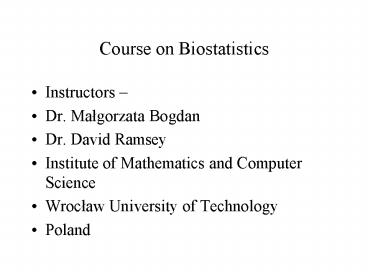Course on Biostatistics - PowerPoint PPT Presentation
1 / 28
Title:
Course on Biostatistics
Description:
Title: Intensity-Dependent Normalization Author: Preferred Customer Last modified by: Instytut Matematyki i Informatyki Created Date: 1/16/2002 2:22:32 AM – PowerPoint PPT presentation
Number of Views:204
Avg rating:3.0/5.0
Title: Course on Biostatistics
1
Course on Biostatistics
- Instructors
- Dr. Malgorzata Bogdan
- Dr. David Ramsey
- Institute of Mathematics and Computer Science
- Wroclaw University of Technology
- Poland
2
Course on Biostatistics
- Two parts
- 1. Locating genes influencing quantitative traits
in experimental populations. - 20.03-30.03. 2006, Malgorzata Bogdan
- 2. Population Genetics
- 22.05-2.06.2006, David Ramsey
3
Grading
- Students can gain 50 points for each part of the
course (25 for a project, 25 for an exam). - The final grade will be based on the total
percentage. - To pass the course the student has to gain at
least 15 points for each part of the course and
at least 50 points in total.
4
First part
- Locating genes influencing quantitative traits in
experimental populations. - 20.03-30.03. 2006 Malgorzata Bogdan
5
Course Outline
- Introduction to genetics and experimental
populations. - Basic methods of locating quantitative trait loci
(QTL). - Locating QTL with QTL Cartographer.
6
Helpful materials
- Text book
- Genetics and Analysis of Quantitative Traits by
Michael Lynch and Bruce Walsh - Software Windows QTL Cartographer
- S.Wang, C.J. Basten, Z-B. Zeng
- Program in Statistical Genetics, North Carolina
State University - Can be downloaded from
- http//statgen.ncsu.edu/qtlcart/WQTLCart.htm
7
Main Goal
- Learn how to locate regions of the genome hosting
genes influencing some quantitative traits
(Quantitative Trait Loci QTL). - Statistical methods mainly linear models.
8
Introduction to Genetics
DNA - A nucleic acid that carries the genetic
information in the cell. DNA consists of two
long chains of nucleotides joined by hydrogen
bonds between the complementary bases adenine
and thymine or cytosine and guanine. The
sequence of nucleotides determines individual
hereditary characteristics. http//www.answers.c
om/topic/dna
9
Introduction to Genetics
- Chromosome a long, continuous piece of
DNA, which contains many genes, regulatory
elements and other intervening nucleotide
sequences. - Diploid organisms chromosomes appear in pairs
(one from each parent)
10
- Allele - any of two or more alternative forms of
a gene that occupy the same locus on a
chromosome. - Example allele of blue eyes, allele of brown
eyes - Genotype at a single locus the pair of alleles
that individual carries at the locus.
11
The Hardy-Weinberg principle
- Random mating
- pa- frequency of a allele
- pA- frequency of A allele
- P(aa)p2a
- P(aA)2papA
- P(AA)p2A
12
- Phenotype observed or measured characteristic
(or trait) for an individual. - We will be dealing with quantitative traits like
eg. height, yield, blood pressure etc.
13
Heritability
- Z - the phenotypic (trait) value of an individual
- G the genotypic value (the sum of the total
effects of all loci on the trait) - E an environmental deviation
- Z G E
- Broad sense heritability (population parameter)
- H2 Var (G) / Var (Z)
14
The influence of a single locus
15
Fishers decomposition of the Genotypic Value
- Consider a biallelic locus with alleles a, A
- N number of alleles a for a given
individual - (gene content)
- We regress G on N
- Var(G) ?2A ?2D
16
(No Transcript)
17
Trait Influenced by Two Loci
- Gijkl mean phenotype for individuals with
- genotypes (i j k l)
- ai Gi- ?G - additive effect of i allele
- dij Gij..- ?G - ai - aj - dominance effects
at the first locus - dkl Gkl..- ?G - ak - al - dominance effects
at the second locus
18
Possible interactions (epistasis)
- (aa)ikGi.k.- ?G ai ak
- (ad)ikl
- Gi.kl.- ?G ai ak al dkl- (aa)ik-
(aa)il - (dd)ijkl Gijkl.- ?G ai aj ak al dij -
dkl - - (aa)ik- (aa)il-(aa)jk- (aa)jl
- - (ad)ikl- (ad)jkl - (ad)ijk-
(ad)ijl
19
Example (Lynch and Walsh)
- Teosinte wild progenitor of cultivated maize
- Two loci (markers) - UMC107 , BV302
- UM, BM maize alleles
- UT, BT teosinte alleles
- Trait the average length of the vegetative
internodes in the lateral branch (in mm)
20
Mean trait values
UMC107 UMC107 UMC107
BV302 UMM UMT UTT
BMM 18.0 40.9 61.1
BMT 54.6 47.6 66.5
BTT 47.8 83.6 101.7
21
Genotype Frequencies
UMC107 UMC107 UMC107
BV302 UMM UMT UTT
BMM
BMT
BTT
22
Cockerham model 1
23
Cockerham model 2
24
Cockerham model 3two loci
25
Genetic maps
- Markers genetic loci which express
experimentally detectable variation between
individuals. - Genetic map gives an order of markers on a
chromosome and a distance between them. - 1 Morgan the expected value of the number of
crossovers is equal to 1
26
(No Transcript)
27
Genetic map
28
low fat content a b q c d a b q c d
high fat content A B Q C D A B Q C D
A B Q C D A B Q C D
a b q c d A B Q C D
BC
A B Q C D A B Q C D
a B Q C d A B Q C D
a b q c d A B Q C D
A B q c d A B Q C D






























